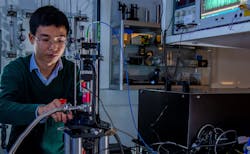Optical forces dynamically reconfigure nanomechanical photonic metamaterials
The Nanophotonics and Metamaterials research group at the University of Southampton’s Optoelectronics Research Centre (Southampton, U.K.) is pioneering the field of nanomechanical photonic metamaterials.
Almost a decade ago, the possibility of optomechanical asymmetry, whereby optical forces could be engaged to dynamically reconfigure a structure differently for opposing directions of light propagation—delivering different optical properties—was first predicted in computational modeling.1
Until now, this concept remained unrealized because of the challenges involved in manufacturing a suitable metamaterial and designing an experiment in which the effect could be unambiguously observed.
“We’re all familiar with phase transitions and the fact that changing the arrangement of atoms or molecules within a material will change its properties,” says Kevin MacDonald, a professor of nanophotonics. “In optical device applications, think of the light-induced amorphous-crystalline transitions in chalcogenide glass that underpin rewritable CD/DVD technology, or the electrically driven changes in molecular orientation or mutual arrangement harnessed in liquid crystal displays.”
Driving reversible structural transitions
Nanomechanical photonic metamaterials represent a highly adaptable platform in which external electric, magnetic, thermal, acoustic, and optical stimuli can similarly be engaged to drive reversible structural transitions in the form of pico- to nanometer-scale displacements of the “meta-atom” building blocks—modulating the optical (visible to near-infrared) properties of the metamaterial ensemble.
“In this work, we harness nonthermal optical forces generated within an all-dielectric nanomechanical metamaterial—between neighboring silicon meta-atoms supported on a flexible silicon nitride framework—to dynamically reconfigure the structure in a manner that depends upon the direction of light propagation,” says MacDonald. “So there’s a light-induced change in the optical properties of the medium that is different for nominally ‘forward’ and ‘backward’ illumination directions.”
This work shows how a strong optical nonlinearity can be achieved by coupling optical and mechanical resonances—enabling all-optical (light-by-light) transmission modulation at microwatt power levels in structures only a fraction of a wavelength thick.
These nano-optomechanical “metadevices” present new opportunities for the development of compact, low-power photonic switching devices.
“The most pleasing aspect of this work is that in experimental measurements of metamaterial transmission, we can identify and clearly discriminate between signatures of picometric-scale thermal (Brownian) and optically induced motion of individual mechanical elements of the metamaterial, and in the latter case between thermal and nonthermal driving mechanisms—i.e., optically induced heating vs. optical forces,” MacDonald says.
What’s next? “We continue to explore the physics and technology of light-matter interactions in nanostructured materials, including techniques for the visualization and optical control of nano- to picoscale motion, under an Engineering and Physical Science Research Council (EPSRC) Programme Grant on next-generation metrology driven by nanophotonics,” says MacDonald.
REFERENCE
1. Zhang et al., Light Sci. Appl., 2, e96 (2013).
RELATED READING
J. Li, K. F. MacDonald, and N. I. Zheludev, “Reconfiguring Photonic Metamaterials with the Pressure of Light,” Conference on Lasers and Electro-Optics, Technical Digest Series (Optica Publishing Group), paper FTh2D.6 (2022); https://doi.org/10.1364/cleo_qels.2022.fth2d.6.
About the Author
Sally Cole Johnson
Editor in Chief
Sally Cole Johnson, Laser Focus World’s editor in chief, is a science and technology journalist who specializes in physics and semiconductors.

